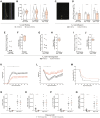MCAM+ brain endothelial cells contribute to neuroinflammation by recruiting pathogenic CD4+ T lymphocytes
- PMID: 36319587
- PMCID: PMC10115172
- DOI: 10.1093/brain/awac389
MCAM+ brain endothelial cells contribute to neuroinflammation by recruiting pathogenic CD4+ T lymphocytes
Abstract
The trafficking of autoreactive leucocytes across the blood-brain barrier endothelium is a hallmark of multiple sclerosis pathogenesis. Although the blood-brain barrier endothelium represents one of the main CNS borders to interact with the infiltrating leucocytes, its exact contribution to neuroinflammation remains understudied. Here, we show that Mcam identifies inflammatory brain endothelial cells with pro-migratory transcriptomic signature during experimental autoimmune encephalomyelitis. In addition, MCAM was preferentially upregulated on blood-brain barrier endothelial cells in multiple sclerosis lesions in situ and at experimental autoimmune encephalomyelitis disease onset by molecular MRI. In vitro and in vivo, we demonstrate that MCAM on blood-brain barrier endothelial cells contributes to experimental autoimmune encephalomyelitis development by promoting the cellular trafficking of TH1 and TH17 lymphocytes across the blood-brain barrier. Last, we showcase ST14 as an immune ligand to brain endothelial MCAM, enriched on CD4+ T lymphocytes that cross the blood-brain barrier in vitro, in vivo and in multiple sclerosis lesions as detected by flow cytometry on rapid autopsy derived brain tissue from multiple sclerosis patients. Collectively, our findings reveal that MCAM is at the centre of a pathological pathway used by brain endothelial cells to recruit pathogenic CD4+ T lymphocyte from circulation early during neuroinflammation. The therapeutic targeting of this mechanism is a promising avenue to treat multiple sclerosis.
Keywords: BBB endothelial cells; CNS infiltration; MCAM; blood–brain barrier; experimental autoimmune encephalomyelitis; multiple sclerosis.
© The Author(s) 2022. Published by Oxford University Press on behalf of the Guarantors of Brain.
Conflict of interest statement
R.C., C.L., N.A. and A.P. are inventors on patents and patent applications related to MCAM modulation and uses thereof (CA2676962C, AU2009212789B2, US8293468B2 and US9017682B2). A.P. is an inventor on patents and patent applications related to DICAM-specific antibodies and uses thereof (US10428144B2, WO2016095046A1, EP3233919B1 and CA2971364A1). E.P. is currently an employee of Immunic AG and owns stock options of the parent company of Immunic AG.
Figures





Comment in
-
Targeting MCAM for next-generation modulation of leucocyte trafficking.Brain. 2023 Apr 19;146(4):1236-1237. doi: 10.1093/brain/awad079. Brain. 2023. PMID: 36946303 Free PMC article.
References
Publication types
MeSH terms
Substances
LinkOut - more resources
Full Text Sources
Medical
Molecular Biology Databases
Research Materials

